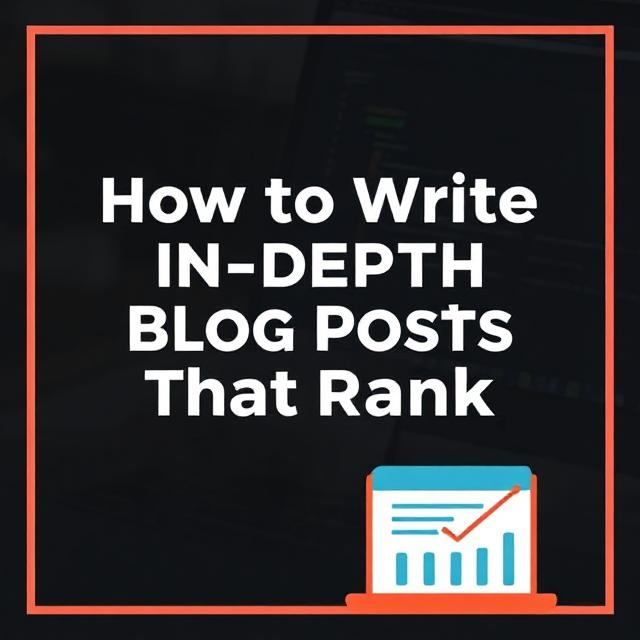
Writing high-quality blog posts that rank on search engines is both an art and a science. Google and other search engines reward content that is well-researched, user-friendly, and informative. This guide will walk you through the essential steps to create in-depth blog posts that not only attract readers but also rank higher on search engine results pages (SERPs).
1. Understand the Purpose of an In-Depth Blog Post
Before you begin writing, it’s crucial to understand why in-depth blog posts perform well. Search engines prioritize content that provides comprehensive answers to users’ queries. Long-form content is often favored because it:
- Offers greater value to readers.
- Increases time spent on the page.
- Attracts more backlinks.
- Encourages social sharing.
In-depth blog posts are typically 1,500 to 3,000+ words long and cover topics thoroughly from multiple angles.
2. Choose the Right Topic
A successful blog post starts with the right topic. To find a topic that resonates with your audience and ranks well:
- Conduct Keyword Research: Use tools like Ahrefs, SEMrush, or Google Keyword Planner to identify high-volume, low-competition keywords.
- Focus on User Intent: Understand the purpose behind the search. Are users looking for information, solutions, or products?
- Analyze Competitors: Study top-ranking blog posts on your chosen topic to understand what works.
💡 Example: If your niche is digital marketing, writing a detailed guide on “How to Create a Content Marketing Strategy” might be more valuable than a general post on “Content Marketing.”
3. Structure Your Post for Readability
A well-structured post is easier to read and more likely to rank. Use a clear and logical structure:
- Introduction: Hook the reader and introduce the topic. Explain what they’ll gain from the post.
- Main Content: Break the content into sections with descriptive subheadings (H2, H3, H4).
- Conclusion: Summarize key points and include a call to action (CTA).
Use formatting to enhance readability:
- Bullet points and numbered lists.
- Short paragraphs (2-3 sentences).
- Bold and italicized text to emphasize key points.
- Visual elements like images, infographics, and videos.
4. Write High-Quality, Original Content
Content quality is non-negotiable. Google’s algorithm prioritizes original, valuable content that meets user expectations. Here’s how to create it:
- Provide Unique Insights: Share your personal experiences, case studies, or expert opinions.
- Be Thorough: Cover every relevant aspect of the topic to ensure readers get all the information they need.
- Avoid Fluff: Every sentence should add value. Cut out unnecessary words and phrases.
5. Optimize for SEO Without Overdoing It
SEO is critical for ranking, but it’s essential to strike a balance. Follow these steps for on-page optimization:
- Keyword Placement: Include your primary keyword in the title, first 100 words, subheadings, and meta description.
- Meta Description: Write a compelling meta description to improve click-through rates (CTR).
- Internal and External Links: Link to relevant internal blog posts and high-authority external sources.
- Use Alt Text for Images: Ensure images are optimized for SEO with descriptive alt text.
- Improve Page Speed: Fast-loading pages rank higher and reduce bounce rates.
6. Incorporate Visuals and Multimedia
Adding visuals and multimedia enhances user experience and keeps readers engaged. Consider including:
- High-Quality Images: Use relevant and attractive images to break up text.
- Infographics: Summarize complex data visually.
- Videos: Embed videos to explain concepts or provide tutorials.
Visual content not only improves readability but also increases the likelihood of social sharing.
7. Promote and Update Your Post Regularly
Writing the post is only half the battle. Promotion and regular updates help it stay relevant and attract more readers.
- Share on Social Media: Promote your post across multiple platforms.
- Build Backlinks: Reach out to relevant sites for backlink opportunities.
- Update Content Periodically: Refresh your content with new information, images, and updated stats.
8. Monitor Performance and Optimize Further
Use analytics tools to monitor your post’s performance. Key metrics to track include:
- Organic Traffic
- Bounce Rate
- Time on Page
- Backlinks
- Social Shares
Analyze these metrics and make necessary adjustments to improve your post’s ranking.
Creating an in-depth blog post that ranks requires planning, research, and consistent effort. By choosing the right topic, structuring your post effectively, and optimizing it for SEO, you can increase your chances of success. Remember, your ultimate goal is to provide value to your readers—do that, and the rankings will follow.
Now, it’s your turn! Start writing and see how your content makes an impact on the web.

